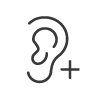Hearing is key to your health. We’re here to help.
Did you know that 1 in 2 US adults report hearing difficulty, yet only 11% of those have been treated?*
Good hearing is important to your overall physical, emotional, and social well-being. Getting a hearing evaluation is a great step towards taking care of your hearing health.

TruHearing® is dedicated to reconnecting people to the richness of life through more affordable hearing care.
If you’re one of the 160 million people covered by TruHearing, our vast network of providers can give you in-depth information about your hearing health and help find the right hearing aids for you.
Download your free guide.
Get the most out of of your hearing evaluation. This guide will help you learn more about what to expect at your exam. You’ll also get an easy-to-fill-out questionnaire to help you prepare for your appointment.

Hearing tests explained.
A comprehensive hearing evaluation takes several different tests into account. Download the guide to find out more about each test.

Otoscopy
Otoscopy

Tympanometry
Tympanometry

Air & bone conduction testing
Air & bone conduction testing

Speech testing
Speech testing

Types of hearing loss.
The results of your exam will show if you have hearing loss as well as the degree and type. There are three types of hearing loss:
Sensorineural hearing loss involves damage to the inner ear which may be caused by aging, noise exposure, ototoxic medications, and some types of illness. Hearing aids are most often used to treat this type of hearing loss.
Conductive hearing loss occurs when sound is not being transmitted through the outer or middle ear to the inner ear. Excessive earwax, fluid in the middle ear, or a damaged eardrum are common causes—this type of hearing loss can often be treated medically or surgically.
Mixed hearing loss is a combination of sensorineural and conductive hearing loss.

Take the next step towards better hearing today.
We can work with your health plan to verify your hearing health benefit. Contact us by calling, emailing, or using the chat button in the bottom right-hand corner.
